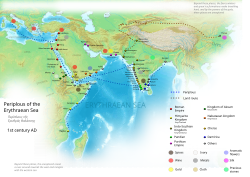Trade route

A trade route is a series of paths or roads that is used for the commercial transport of cargo.
Historically, the period from 1500 BC–1 AD saw the Western Asian, Mediterranean, Chinese and Indian societies develop major networks for trade, such as the silk road.[1] Europe's early trading routes included the amber road, which served as a network for long distance trade.[2] Maritime trade along the spice route became prominent during the Middle Ages; nations tried to control this influential route.[3] During the Middle Ages organizations such as the Hanseatic League, aimed at protecting interests of the merchants and trade, also became increasingly important.[4]
In modern times, commercial activity shifted from the major trade routes of the Old World to newer routes between modern nation states. This activity was sometimes carried out without traditional protection of trade and under international free trade agreements, which allowed commercial goods to cross borders with relaxed restrictions.[5] Innovative transportation of the modern times includes pipeline transport, and the relatively well known trade using rail routes, automobiles and cargo airlines. In some select cases, pipelines can even transport solids, such as coal and other minerals, over long distances; short-distance transportation of goods such as grain, cement, concrete, solid wastes, pulp etc. is also feasible.[6]
Trade Route Media
A Javanese jong, a large Javanese vessel from the 11th−17th century. Shown with the characteristic tanja sail of Southeast Asian Austronesians.
Much of the Radhanites' Indian Ocean trade would have depended on coastal cargo-ships such as this dhow.
Trading routes used around the 1st century CE centred on the Silk Road.
The Via Maris (purple), King's Highway (red), and other ancient Levantine trade routes, c. 1300 BCE.
Saharan trade routes circa 1400, with the modern territory of Niger highlighted; Tuareg people, who exercised influence over the Trans Saharan Trade.
Austronesian proto-historic and historic maritime trade network in the Indian Ocean
Other websites
Notes
References
- Burns, Thomas Samuel (2003). Rome and the Barbarians, 100 B.C.-A.D. 400. Johns Hopkins University Press. ISBN 0801873061.
- Denemark, Robert Allen; et al. (2000). World System History: The Social Science of Long-Term Change. Routledge. ISBN 0415232767.
- Dollinger, Philippe (1999). The German Hansa. Routledge. ISBN 041519072X.
- Donkin, Robin A. (2003). Between East and West: The Moluccas and the Traffic in Spices Up to the Arrival of Europeans. Diane Publishing Company. ISBN 0871692481.







